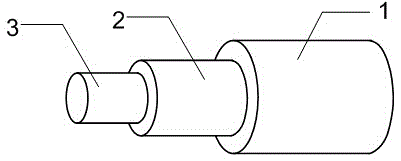Multilayer core-shell nano-fiber scaffold, and method for constructing tissue engineering material by using multilayer core-shell nano-fiber scaffold and melanocyte
A multi-layer core-shell structure and nanofiber technology, applied in the field of biomedicine, to achieve good mechanical properties, good shape, and improve material strength
- Summary
- Abstract
- Description
- Claims
- Application Information
AI Technical Summary
Problems solved by technology
Method used
Image
Examples
Embodiment 1
[0052] Embodiment 1. Preparation of chitosan-polyethylene oxide-polyethylene oxide multilayer core-shell nanofiber scaffold material
[0053] A. chitosan is dissolved with trifluoroacetic acid / dichloromethane weight ratio 3:1 mixed solvent, is made into the shell solution that concentration is 5%;
[0054] B. Dissolve polyethylene oxide, polyethylene glycol methacrylate, and polyethylene glycol dimethacrylate in water at a weight ratio of 80:20:1 to form a middle layer solution with a concentration of 5%. Add 1% photoinitiator 1-[4-(2-hydroxyethoxy) phenyl]-2-hydroxyl-2methyl-1-propan-1-one before spinning;
[0055] C. polyethylene oxide is dissolved in water to make a concentration of 4% nuclear layer solution;
[0056] D. Electrospinning is carried out under the conditions of voltage of 15KV, three-layer propulsion rate of 0.5ml / h, receiving distance of 15cm, temperature of 30oC, and ultraviolet light irradiation;
[0057] E. drying the multi-layer core-shell nanofiber sup...
Embodiment 2
[0062] Example 2. Preparation of chitosan-polyvinylpyrrolidone-polylactic acid core-shell nanofiber scaffold material
[0063] A. Dissolve chitosan with acetic acid / water (weight ratio 1:1) mixed solvent to make a chitosan / polyethylene oxide solution with a concentration of 4%;
[0064] B. Dissolve vinylpyrrolidone, hydroxyethyl methacrylate, and N,N'-methylenebisacrylamide in water at a weight ratio of 70:30:3 to form a 6% nuclear layer solution. Add 3% photoinitiator phenyl bis(2,4,6-trimethylbenzoyl) phosphine oxide before spinning;
[0065] C. Polylactic acid is dissolved with dichloromethane to make a solution with a concentration of 7%;
[0066] D. Under the conditions of 20KV voltage, 0.5ml / h shell propulsion rate, 0.8, 0.4, 0.4ml / h shell, middle and core propulsion speeds, receiving distance 18cm, temperature 20oC, and ultraviolet light perform electrospinning;
[0067] E. the chitosan-polyvinylpyrrolidone-polylactic acid multilayer core-shell nanofiber scaffold was b...
Embodiment 3
[0072] Example 3. Preparation of gelatin-polyvinyl alcohol-polyvinylpyrrolidone core-shell nanofiber scaffold material
[0073] A. Dissolve the gelatin with trifluoroethanol / water (mass ratio 8:2) to make a 10% gelatin solution;
[0074] B. Dissolve polyvinyl alcohol, methacrylic acid, and ethylene glycol dimethacrylate in acetic acid / water (mass ratio 1:1) at a weight ratio of 60:40:0.4, and the concentration is 3%. The core layer solution, add 0.2% photoinitiator 2-hydroxyl-1-[4-(hydroxyl) phenyl]-2-methyl-1-propanone before spinning;
[0075] C. Electrospinning is carried out at a voltage of 25KV, a shell-layer propulsion rate of 1ml / h, a core-layer propulsion rate of 0.5ml / h, a receiving distance of 20cm, a temperature of 40oC, and ultraviolet light;
[0076] D. dissolving polyvinylpyrrolidone with ethanol to make a concentration of 8% nuclear layer solution;
[0077] E. Bake the gelatin-polyvinyl alcohol-polyvinylpyrrolidone multilayer core-shell nanofiber scaffold unde...
PUM
| Property | Measurement | Unit |
|---|---|---|
| quality score | aaaaa | aaaaa |
Abstract
Description
Claims
Application Information
 Login to View More
Login to View More - R&D
- Intellectual Property
- Life Sciences
- Materials
- Tech Scout
- Unparalleled Data Quality
- Higher Quality Content
- 60% Fewer Hallucinations
Browse by: Latest US Patents, China's latest patents, Technical Efficacy Thesaurus, Application Domain, Technology Topic, Popular Technical Reports.
© 2025 PatSnap. All rights reserved.Legal|Privacy policy|Modern Slavery Act Transparency Statement|Sitemap|About US| Contact US: help@patsnap.com

